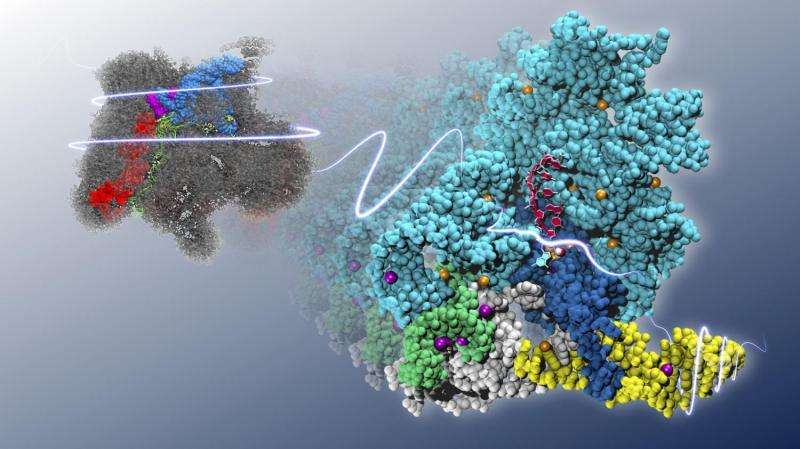The RNA that snips and stitches RNA

RNA is a fundamental molecule that codes for protein and controls gene expression, playing a part in regulating many cell responses and vital processes. The genetic information contained in premature messenger RNA (mRNA), before being converted to proteins, needs to be processed and cleared of its non-coding sections, known as introns. In several simpler organisms, this key process is carried out by group II introns, enzymes entirely made up of RNA (different from the true protein enzymes) called ribozymes that are able to self-cleave by removing themselves from the mRNA filament and thereby promoting RNA maturation.
A SISSA/CNR-IOM Democritos study carried out in collaboration with the École Polytechnique Fédérale de Lausanne (EPFL) gives a detailed account of the cleavage reaction, so far totally unknown. The mechanism is thought to be similar to that of the human spliceosome whose malfunctioning can lead to several diseases among which neurodegeneration and cancer. The study has been published in the Journal of the American Chemical Society.
Messenger RNA (mRNA) is made up of exons and introns, that is, portions of genetic information that are "switched on" and "switched off," respectively. In order to reach maturation and be sent to the cellular "machine" that deals with protein synthesis, the non-coding fragments contained in the mRNA, the introns, need to be removed, whereas the coding sequences, the exons, have to be linked together. In humans, this "snipping and stitching" process, known as splicing, is governed by a huge machinery consisting of proteins and RNA, the spliceosome.
In some prokaryotes as well as in the organelles of some eukaryotes, splicing can be self-catalyzed by particular ribozymes with the help of magnesium ions, without the intervention of any protein machinery: the group II introns ribozymes are in fact able to self-regulate their own removal from the filament, thus promoting the maturation of messenger RNA. So far, the exact mechanism by which splicing occurs was unknown, but a new SISSA/CNR-IOM study carried out with the collaboration of the Swiss EPFL has reconstructed in detail – by using computer simulations – the cleavage process for group II introns, considered the ancestors of the spliceosome, thereby shedding light on the much more complex splicing mechanism in humans.
"We studied in detail, by reproducing the reaction conditions, the splicing process carried out by the group II intron ribozyme," explains Lorenzo Casalino, SISSA PhD student and first author of the study. "A ribozyme is a structure composed of RNA which acts as an enzyme, though in a radically different manner from protein enzymes. In humans, instead of group II introns, we have the spliceosome, a huge structure, whose "core" has much structural and catalytic similarities with group II introns, according to recent studies."
"This is the first time we have such a detailed description of the process through which non-coding introns are removed," comments Alessandra Magistrato, CNR-IOM Democritos/SISSA researcher and coordinator of the study. "Our work reveals that the reaction mechanism by which splicing occurs is completely different from what had been thought for decades. It was in fact believed that ribozymes resembled the functioning of protein enzymes, but that is not case: the latter in fact use far more specific methods due to the chemical richness of amino acids, whereas the process in ribozymes adapts to the skeleton of the RNA that forms them, resulting in a slightly slower but equally precise reaction mechanism."
"Given the analogy of group II introns with the central core of the human spliceosome, wich is the important portion for splicing, we think our work can help to guide research and provide a glimpse into the spliceosome," adds Magistrato. Why is it important to understand the mechanism in humans? "Aberrant splicing in humans may lead to various complex diseases and also underlies the development of some forms of cancer and the onset of neurodegenerative diseases, so a better understanding of the process can add important information for our fight against these diseases."
More information: Lorenzo Casalino et al. Who Activates the Nucleophile in Ribozyme Catalysis? An Answer from the Splicing Mechanism of Group II Introns, Journal of the American Chemical Society (2016). DOI: 10.1021/jacs.6b01363
Journal information: Journal of the American Chemical Society
Provided by Sissa Medialab

















